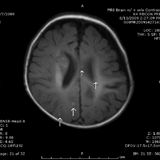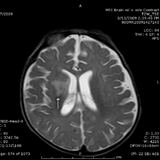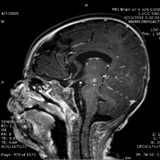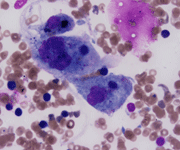A 4-month-old boy with 2 weeks of poor feeding, cough
Click Here to Manage Email Alerts
The guest columnist this month is Ronen Zipkin, MD, who is an academic Hospitalist at Children’s Hospital of Los Angeles.
A 4-month-old boy presented with parents complaining of 2 weeks of poor feeding, cough, abdominal distention and intermittent fevers.
He was initially diagnosed with a viral illness and prescribed an unknown antibiotic without improvement. He soon became more fussy and febrile with fevers up to 103·F, along with decreased urinary output, diarrhea and weight loss of 2 lbs. He was referred to a tertiary care center for a higher level of care. Except for these problems, his review of systems was otherwise normal. His family history revealed that his mother recently had a cough; however, there were no other known sick contacts, recent travel or animal exposure. His birth history was unremarkable and he was up to date on his immunizations.
 |
|
His chest radiograph in the ED revealed
diffuse nodular infiltrates, hepatosplenomegaly and an enlarged
thymus. |
Examination revealed the following vital signs: temperature of 102·F; heart rate, 160; BP = 90/63; and RR = 60 with an oxygen saturation of 93% on room air. In general, he was fussy with a weak cry, but was consolable.
On auscultation, he had coarse rhonchi bilaterally and normal heart sounds. He had marked hepatosplenomegaly, with the liver edge palpated 4 cm below the right costal margin and the spleen tip 3 cm below the left costal margin. There was no rash, and neurologically, he had normal tone and strength throughout with no focal deficit. The rest of his exam was also normal.
 |
 |
 |
|
MRI of the brain was done, which revealed
multiple enhancing nodules in the leptomeningeal distribution, as well as
involvement of the basal ganglia, midbrain and cervical cord at the level of
C3. |
||
His chest radiograph in the ED revealed diffuse nodular infiltrates, hepatosplenomegaly and an enlarged thymus (Figure 1). Initial laboratory tests revealed a white blood cell count of 18,000 with 55% neutrophils and 24% bands; Hgb, 9.1 g/dL; Hct, 28.7%; platelet count, 283
K/uL. Chemistries showed a sodium of 125 mEq/L, potassium 6.3 mEq/L, aspartate aminotransferase, 52 U/L; alanine aminotransferase, 29 U/L; albumin, 2.3 g/dL; LDH, 1,221 U/L (normal, 425 to 975 U/L); ferritin, 960 ng/mL (normal, 50 to 200 ng/mL); triglycerides, 210 mg/dL; fibrinogen 104 mg% (normal, 150-400 mg%). The cerebrospinal fluid revealed two RBCs, 27 WBCs with 79% neutrophils and 9% monocytes, glucose of 31 and protein of 124. HIV PCR, syphilis rapid plasma reagin, Epstein-Barr virus serology, titers for coccidiomycosis and histoplasma, as well as gastric aspirates for TB are pending. (Hint: The HIV, syphilis and EBV tests quickly came back negative).
Due to worsening fussiness, ongoing fevers and evidence of meningitis, an MRI of the brain was done, which revealed multiple enhancing nodules in the leptomeningeal distribution, as well as involvement of the basal ganglia, midbrain and cervical cord at the level of C3 (Figures 2-4).
Due to the presence of marked hepatosplenomegaly, anemia, elevated ferritin and LDH levels, as well as low fibrinogen, a bone marrow aspirate was obtained, which is represented in Figure 5 (Hint: The three blue cells are histiocytes).
 |
|
The three blue cells are
histiocytes. |
What’s Your Diagnosis?
- Disseminated coccidiomycosis
- Disseminated histoplasmosis
- Miliary TB with hemophagocytic lymphohistiocytosis (HLH)
- Langerhans cell histiocytosis
This is a case of miliary tuberculosis with secondary hemophagocytic lymphohistiocytosis (C).
Miliary TB occurs when bacteremia from an overwhelming mycobacterium infection results in disease of two or more organs. It is often a disease of infants and young children. The organs most often affected include the lungs, spleen, liver and bone marrow.
Clinical manifestations of primary M. TB infection are largely based on the host immune response. Most infected children have a positive purified protein derivative (PPD) skin test with little to no symptoms.
When disease occurs, clinical manifestations can include fever, cough, poor weight gain or failure to thrive. Those who progress to miliary TB often have a failure to activate an appropriate TH1-mediated response, which is needed to help eliminate bacilli. Miliary TB can be an acute illness, occurring over several days; however, it is more often an indolent process.
Early signs include malaise, weight loss and low grade fevers. These can progress into marked hepatosplenomegaly and neurologic involvement as a result of meningitis, which occurs in 20% to 30% of patients. Cough and respiratory distress often occur several weeks later as the lungs become filled with tubercles (resembling millet seeds). Radiographic findings can be normal or include diffuse reticulovascular disease, raising the suspicion for concomitant comorbidities such as leukemia, histoplasmosis, HIV and histiocytosis. The initial chest radiograph on our patient was concerning for a possible leukemic infiltration of the thymus; however, this was later felt to be less likely based on the absence of premature lymphocytes and myeloblasts on the peripheral smear. The brain MRI was suggestive of a disseminated infectious process. HLH can also present with lesions in the leptomeningeal and parenchymal regions from infiltrated macrophages; however, it was not until we had results of Mycobacterium TB DNA PCR on the CSF that we were able to confirm TB meningitis.

Vice Chair for Education at The Children’s Hospital at Scott
and White and Associate Professor of Pediatrics at Texas A&M University,
College of Medicine, Temple, Texas. E-mail: jhbrien@aol.com.
e-mail:jhbrien@aol.com
Histiocytic disorders are due to proliferation of cells in the monocyte-macrophage system, and, according to WHO system of classification, are divided into three separate categories. Class I disease, which includes Langerhans cell histiocytosis (LCH), Letterer-Siwe disease and Hand-Schüller-Christian disease, is characterized by rapid accumulation of the antigen presenting Langerhans cell. This class of disease typically involves a single site, such as skin, bone or lymph node, and often requires only local therapy for isolated lesions. Class III histiocytic disorders include malignant processes such as acute monocytic leukemia (AML) and acute myelomonocytic leukemia.
HLH is a class II histiocytic disorder and is characterized by proliferation of phagocytic macrophages and lymphocytes. There are two conditions that are very similar in both clinical presentation as well as long-term outcome. Familial HLH often presents in infancy or early childhood and refers to the presence of an underlying genetic disorder. Secondary HLH may occur at any age, may subside spontaneously and is often caused by an underlying condition, such as HIV, TB or EBV infection. A similar disorder, macrophage activation syndrome (MAS), primarily occurs in patients with juvenile idiopathic arthritis (JIA) or systemic lupus erythematosus (SLE).
HLH typically affects infants from birth to 18 months. Unfortunately, the diagnosis is often made late in the course, after irreversible damage has already occurred. The five major criteria for the diagnosis of HLH are: (1) fever > 38.5·C for more than 7 days, (2) splenomegaly more than 3 cm below the costal margin; (3) cytopenia involving two or more cell lines; (4) hypertriglyceridemia or hypofibrinogenemia; and (5) hemophagocytosis demonstrated on bone marrow examination (figure 5 revealing three histiocytes – top histiocyte with ingested debris; middle histiocyte with one ingested nucleated RBC and multiple platelets; bottom histiocyte with ingested platelets and one lymphocyte). Alternative criteria that can substitute for any of the major criteria include low or absent natural killer cell activity, serum ferritin > 500 ug/L, or soluble IL-2 receptor level > 2,400 U/mL. Our patient’s receptor level was 33,061 u/mL, which is three times the upper limit of normal. He also displayed decreased natural killer cell function.
HLH is often fatal if left untreated and, therefore, must always be considered in the differential for patients presenting with fever, organomegaly and evidence of bone marrow suppression. Survival rates have dramatically improved with the advent of the HLH-2004 treatment protocol established by the Histiocytosis Association of America. Patients are typically started on high-dose dexamethasone, as well as chemotherapeutic agents such as VP-16 and cyclosporine. Intrathecal methotrexate is used in cases with progressive neurological symptoms or persistent CSF disease.
The goal of therapy is to maintain clinical stability until an appropriate bone marrow donor can be arranged.
Treating the underlying cause is essential in the successful treatment of secondary HLH. The treatment of drug-susceptible pulmonary or extrapulmonary TB disease (without meningitis) begins with 2 months of isoniazid, rifampin and pyrazinamide followed by 4 months of isoniazid and rifampin. Patients with confirmed TB meningitis should be started on the same three-drug regimen above for 2 months with a fourth drug, usually ethambutol or an aminoglycoside, followed by 7 to 10 months of rifampin and isoniazid. Side effects such as optic neuritis with the use of ethambutol are exceedingly rare in children, especially in those with normal renal function. It is strongly advisable to consult with a TB expert in complicated cases such as this.
Editor’s comments
I would like to thank Dr. Zipkin (Figure 6) for contributing this very complex and thought-provoking case.
 |
|
Dr. Zipkin received his MD from the University
of California, Irvine, then did his pediatric training, including a chief
resident year, at Children’s Hospital of Orange County from 2004-2008. He
is shown with his daughter, Maya. |
Hopefully, there were enough hints given to arrive at the correct diagnosis. Disseminated fungal infections like coccidioidomycosis, a disease that is endemic in southern California and throughout the southwest, may have similar, multi-system manifestations, which is why we ultimately perform many tests on patients such as this. In August, I presented a case of a newborn with Langerhans Cell Histiocytosis, with skin manifestations at birth. The spectrum of histiocytic infiltrative disorders is very confusing and suffers from a lack of a uniformed system of classification.
As a result, physicians who are not hematologists often times remain confused when it comes to understanding these diseases. At least we can be aware of them and include them in the differential diagnosis when we are faced with a child with a multi-system illness or an unusual problem, like a solitary lytic bone lesion without an obvious cause. Obviously, your hematologist consultant should be involved early on in the work up.
